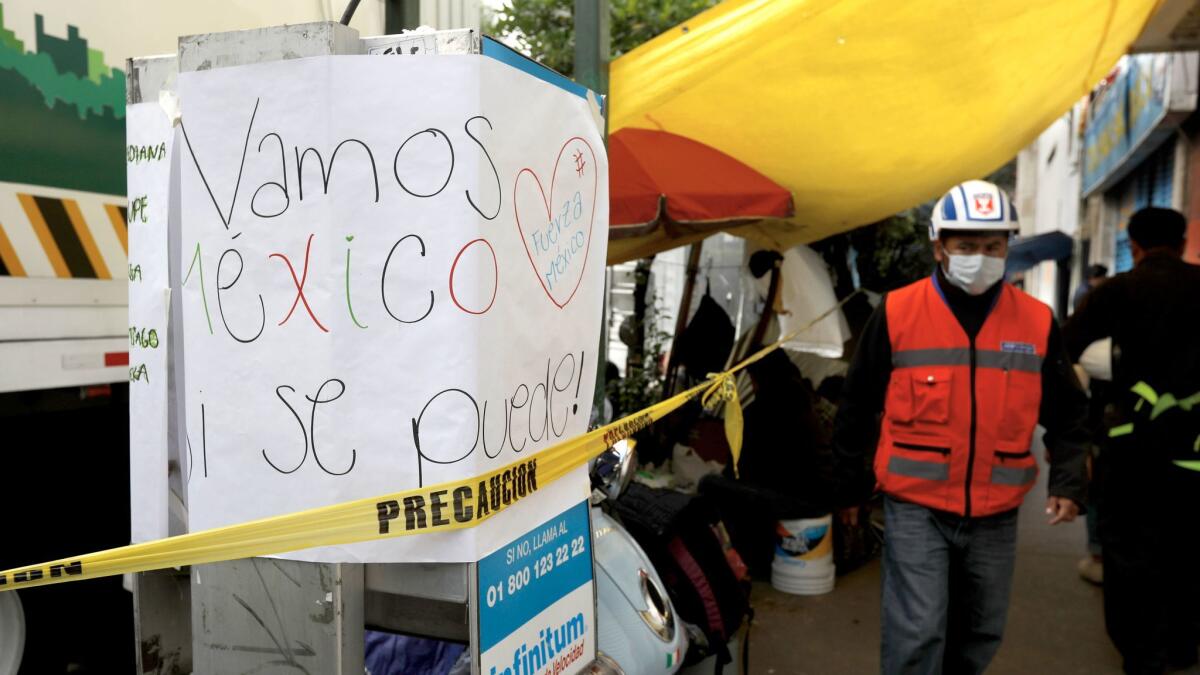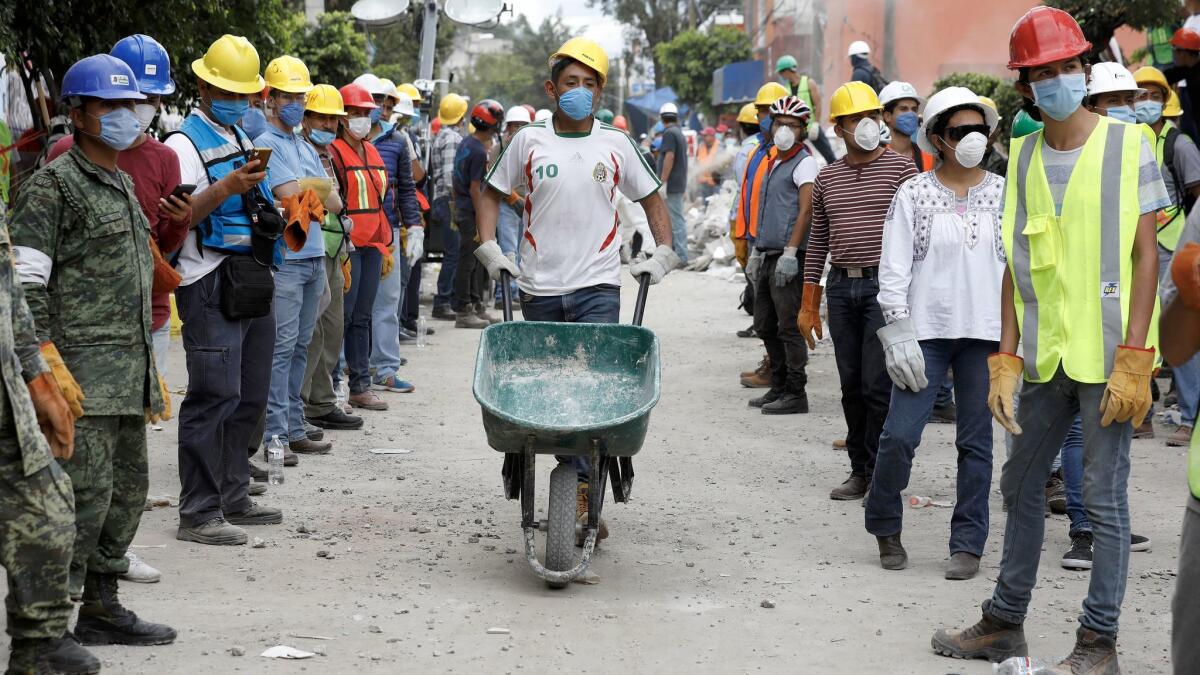âCanta y no lloresâ â âSing and donât cry.â Mexico rebounds from earthquake aftermath with a renewed sense of national pride

Reporting from Mexico City â Mexican flags poke from near the rubble piles of what were once homes, shops and offices.
A group of youthful cheerleaders marches down a street, clapping their hands while rhythmically chanting, âMexico! Mexico!â
Bystanders gathered at the site of a flattened office building break into an impromptu rendition of âCielito Lindo,â the iconic Mexican song, with its adversity-calming refrain: âAy, ay, ay ay. Canta y no lloresâ â âSing and donât cry.â
There would seem to be little to croon about on the streets of this grievously wounded capital, where the aftermath of Tuesdayâs earthquake has left at least 180 dead and forced thousands from their homes. Nationally, the death toll topped 300.
But, along with the edgy sense of apprehension, last weekâs earthquake has seen an extraordinary outpouring of pride and nationalistic passion, in some cases literal flag-waving. People seem compelled to proclaim their mexicanidad â their Mexican-ness.
This in a country where decades of corrupt governance and official impunity have fed a profound sense of skepticism, a distrust of the public sphere and a reliance on family more than community.

A mass outburst of solidarity and volunteerism has gripped seemingly all segments of society, but especially millennials â despite that demographicâs lack of institutional memory of the 1985 earthquake that killed thousands here. The urge to do something is palpable.
âEveryone wants to help, to show their concern,â said Gibrana Cervantes, 28, a violinist who was among volunteers handing out food and clothing Saturday in a park in the hard-hit Condesa district. âIâm part of a group of more than 100 people assisting in various areas, and I donât even know most of them.â
In the capital, there even appears to be an oversupply of donated food, water, clothing, diapers and first aid services â even dog food, sacks of which were piled up for the taking at an aid center at Parque Mexico in Condesa. Spots in evacuation shelters go vacant as many forced from their homes are welcomed by relatives and friends.
Brigades of volunteers, young and old, wander about on foot and on bicycles offering food, clothing, water and other aid from boxes, backpacks and baskets. They implore people to take a sandwich, a pastry, a coffee â something, please. This weekend, a mock Batmobile bearing Mexican flags distributed aid, prompting âBatman to the rescueâ TV headlines. People in wheelchairs, even amputees, have joined the help crews.
The torrent of donations and deluge of aid has morphed into an enhanced sense of patriotism, both on the streets and in social media.
President Trumpâs perceived Mexico-bashing has generated broad uncertainty about the economy and revived dark memories of the countryâs often-problematic relations with its superpower northern neighbor. Anti-Trump sentiment has also united Mexicans to a degree, but not to the extent that reaction to the earthquake has.
The capitalâs massive, on-the-ground response to adversity has spurred a feel-good sense about the country and what many view as its essential character. Dark stereotypes about Mexicans as callous and indifferent to graft and deceit have promptly fallen by the wayside.
âHow proud I am to be a Mexican and to see how many people are helping in the disaster,â wrote one social media user, Mariana Macias, in response to what emerged post-earthquake as a popular Twitter hashtag, #FuerzaMexico â roughly, âStrength in Mexico.â
âNo country in the world unites like Mexicans unite in disasters,â Macias added.
Even as people were reveling in such upbeat sentiments, last weekâs apparently phony saga of âFrida Sofiaâ â the 12-year-old student supposedly trapped in the ruins of the toppled Enrique Rebsamen school â ultimately validated gloomy narratives about a crooked government and press establishment. The story riveted the nation and received around-the-clock TV coverage. But it turned out that Frida Sofia likely never existed.
Yet the fake news about Frida Sofia was largely shrugged off and failed to dampen spirits.
Words in the Mexican national anthem proclaiming âa soldier in every sonâ have been modified in hundreds of placards, graffiti messages and internet posts into an updated motto: âA hero in every son.â
The country seems to have embraced the notion that facing hardship is an essential component of the national makeup â and certainly of the character of the chilangos, as Mexico City residents are known, sometimes not so affectionately, outside of their densely populated metropolis.
In a column in the Milenio newspaper, Carlos Puig noted how Mexico City seemed to suffer from a form of âoriginal sin,â founded as it is in a seismic zone, flanked by active volcanoes and above a now-disappeared lake. The megacity continues to defy nature, erecting ever-larger skyscrapers on tenuous terrain and draining water from the ground. Plumes of ash have been spewing in recent days from the nearby Popocatepetl volcano, another indication of the cityâs vulnerable setting.
Yet the columnist noted that, an hour after last weekâs earthquake struck, his son got on his bike and went out to help people â just like his parents had when the 1985 quake hit.
âHe will make the city his own,â Puig wrote. âAnd he will live always with fear, but with identity.â
Among those most lionized are the rescue workers who burrow inside collapsed buildings seeking signs of life, especially Mexicoâs own topos, or moles, as the volunteer search battalions are known.
At rescue sites, emergency staffers raise their right arms with clenched fists to ask for silence as colleagues listen for signs of life deep inside the wreckage. The clamor of the dig quickly gives way to a church-like quiet, an extraordinary transformation.
Since last weekâs earthquake, the raised fists have taken on new significance â as a generalized symbol of solidarity and at times a rebuff to the countryâs political class.
âTo the corrupt government of Mexico,â wrote Sofia NiĂąo de Rivera in a Twitter message. âFists up for you. Shut up, leave and let us show you how it is done.â
The government has taken notice, especially with national elections scheduled for July. President Enrique PeĂąa Nieto, his popularity rating at near-record-low levels, has been busy making public appearances at disaster sites, aid centers and other earthquake-related venues.
Tens of thousands of troops were quickly deployed in Mexico City to maintain order and assist with recovery. The ruling Institutional Revolutionary Party clearly wants to avoid any suggestion of a laggard effort â or that aid is being diverted or stolen.
The same ruling party was widely assailed after the 1985 quake for its infamously torpid response. Many analysts view the 1985 temblor and its broad social aftershocks as marking the beginning of the fracturing of Mexicoâs once-monolithic ruling party.
Despite its devastating impacts, some view last weekâs earthquake as a kind of hope-infused hinge moment, shifting the countryâs perspective toward unity at a critical time.
âWe were in a situation of great disunion before the earthquake,â said Luis Rodolfo Vasquez Huante, a veterinary professor who was stationed in the Roma neighborhood Saturday, waiting to provide medical aid to any pets injured in the earthquake. âSo out of something bad has come good, because weâve returned to all being Mexicans and watched our national spirit flower.â
As time goes by, the enthusiasm, volunteer spirit and patriotic exuberance seem certain to diminish. The city, and the country, face a massive task of cleanup, inspection, demolition and reconstruction that will likely drag on for years and cost billions of dollars.
âWe should be very proud of our young people,â said Rodolfo Soriano NuĂąez, a public policy analyst. âBut we canât do reconstruction based on volunteerism.â
Meanwhile, the arduous task of seeking those who may be trapped beneath the tons of fallen masonry drags on. In Mexico City on Sunday, workers continued to search through ruins that included an office building in the central neighborhood of Condesa and the Rebsamen school, where 21 children died in the southern part of the city.
Experts say the chance of finding survivors decreases three days after an earthquake, but rescuers have vowed to press on.
The other day, emergency workers removed their hard hats and stood in silence as yet another body was removed from the rubble of what was formerly a five-story apartment block in the capitalâs Tlalpan district. Rescuers carried the body on a stretcher to a waiting morgue van past the sodden debris pile, its sides draped by curtains and bedspreads, remnants of past lives.
Once the ritual was completed, the workers â whose ranks included teams from Israel and Japan â returned to their labors. But not before raising anew their right arms, fists clenched, and declaring in unison: âFuerza Mexico! Fuerza Mexico!â
To read the article in Spanish, click here
Special correspondent Laura Tillman and Cecilia Sanchez of The Timesâ Mexico City bureau contributed to this report.
Twitter: @mcdneville
ALSO
Scientists say latest 6.1 aftershock in Mexico is ânot surprisingâ
In Jojutla, near epicenter of Mexico quake, scenes of heartbreak, loss and survival
More to Read
Sign up for Essential California
The most important California stories and recommendations in your inbox every morning.
You may occasionally receive promotional content from the Los Angeles Times.










